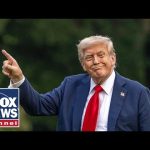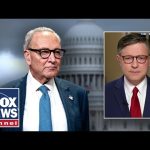President Trump is embarking on a significant journey to Asia, gearing up for serious trade negotiations with some of the world’s most influential leaders. This trip comes just after the President decided to cut off trade talks with Canada, and he is now focused on solidifying deals in Malaysia, Japan, and South Korea. The ultimate test will be his face-to-face meeting with China’s President Xi Jinping, where they will discuss the ongoing trade disputes between their two nations. One couldn’t help but wonder what might transpire when these two powerhouses finally face each other.
This trip is not just about trade; it’s also an opportunity for President Trump to flex America’s muscle in the Caribbean. The U.S. Navy is sending its most sophisticated aircraft carrier, which is no small potatoes. This impressive naval force sends a clear message: America is paying attention to its backyard. By launching this operation, Trump is not only addressing trade issues, but he is also confronting serious threats related to drug trafficking and political instability in neighboring Venezuela.
Tensions are high in the Caribbean, especially concerning Nicolas Maduro, Venezuela’s controversial leader. President Trump has taken a hard stance against Maduro and his government, framing their actions as akin to terrorist activity. The severity of this situation mirrors historical conflicts, showcasing how some drug traffickers now operate almost like armies vying for territory. The President has even authorized the CIA to conduct covert operations in Venezuela to tackle these challenges head-on. It’s like something out of a political thriller, only it’s real-life geopolitics unfolding right before our eyes.
Moreover, this trip underscores America’s renewed focus on its own hemisphere, something many observers argue has long been overlooked. Some have even coined this approach the “Dondero Doctrine,” echoing the principles of the Monroe Doctrine from decades past. This doctrine could signify a shift in priority, tackling threats like drug trafficking and expanding Chinese influence in Latin America, rather than getting embroiled in distant conflicts that don’t seem to serve American interests.
Throughout the discussions, the connection between the Caribbean and China’s expanding presence in the region becomes clear. The President’s efforts to restore stability in Venezuela may have far-reaching implications; if he can successfully navigate the political landscape and support the opposition, then the surrounding countries—like Cuba and Nicaragua—may follow suit in shedding their communist influences. The end goal? To reclaim Latin America for its people and minimize foreign influence, especially from China, as they attempt to colonize resources for their own gain.
In summary, President Trump’s Asian trip is not merely a diplomatic mission; it’s part of a grand strategy to reposition America as a regional leader and to confront challenges closer to home. Whether it’s through trade negotiations or military presence, Trump’s agenda is clear: restore order in the Western Hemisphere while keeping communication lines open with powerful allies in Asia. The days ahead promise to be filled with intense discussions and perhaps, bold actions that could redefine America’s role both at home and abroad.




